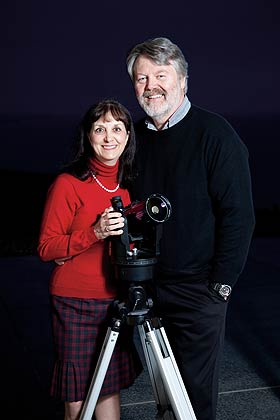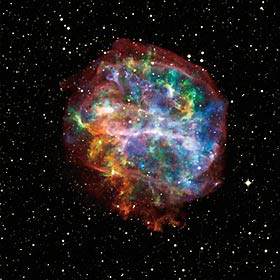
 Professors Lisa and Jeff Smith:
Professors Lisa and Jeff Smith:
They are looking at how to best encourage public interest in space.
You don't need to be an artist to appreciate art and you don't need to be a scientist to appreciate science.
What you do need is clear communication that helps explain what you are looking at and opportunities to have your questions answered easily and simply.
Professors Jeff and Lisa Smith (College of Education) have spent 25 years working on ways to help people understand what they are seeing. Now their research has brought a striking exhibition of images of space to the Otago Museum – the only institution outside the US to host them. Before joining the University of Otago in 2005, the Smiths combined their American university careers with running the office of research and evaluation at the Metropolitan Museum of Art in New York. Over two decades they advised more than 30 of America's top museums about how to improve visitors' educational experiences.
Now, at the College of Education, Jeff is co-director of the Educational Assessment Research Unit and Lisa is Associate Dean (Academic and Research).
One of their current projects is to identify how best to encourage people's appetite for information about space. They joined a group of scientists at the NASA-affiliated Harvard-Smithsonian Centre for Astrophysics to study the interplay among education, aesthetics and astronomy.
The Smiths knew that most people found images of space beautiful, but wondered how well they managed to communicate a scientific message. They discovered that reactions to art and to images of space are similar. The lay public may not have much specific knowledge, but is sufficiently attracted by the wonder of impressive works to want to find out more. Following an initial study that examined reactions to deep space imagery, over the past year the Smiths studied people's reactions to 12 high-quality two-square-metre images of space in an exhibition touring four of the US's best science museums, including the Smithsonian Air and Space Museum.
The fifth and final stop for the exhibition was the Otago Museum. Visitors were asked to rate three different labels describing the images: standard NASA-style information; fun facts that might be related to others later; and provocative questions that people were likely to want answered.
The Smiths' research has already shown that people say they do not want too much information on labels but, once they have some knowledge, they want more.
This finding is already changing how some educators present their material – such as one of the research funders, Harvard's Chandra Observatory, which detects X-ray emissions in the universe. “It's gratifying to see that the astrophysicists are really listening to the results we're getting,” says Lisa. “For example, the Chandra website has now been revamped.
“It now has interactive colour programmes where people can build their own images and they have changed the posters that they send out for educational use.
“So often research does not get as much play out in the real world as you would like to see – but we feel this is really going somewhere.”

Standard explanation:
G292.0+1.8 is a young supernova remnant located in our galaxy. This deep Chandra image shows a spectacularly detailed, rapidly expanding shell of gas that is 36 light years across and contains large amounts of oxygen, neon, magnesium, silicon and sulphur. Astronomers believe that this supernova remnant, one of only three in the Milky Way known to be rich in oxygen, was formed by the collapse and explosion of a massive star. Supernovas are of great interest because they are a primary source of the heavy elements believed to be necessary to form planets and life.
“Cocktail” explanation:
The oxygen we breathe, the iron in our blood, and the calcium in our bones comes in part from exploded stars such as the Cassiopeia A supernova remnant seen here. Most of the elements throughout the Universe, other than hydrogen and helium, were forged in the cores of stars. These elements were then dispersed into space when the stars exploded, later to be used as the building blocks when new stars and planets formed. Our Sun and Solar System – including Earth – contain the materials for life thanks to such previous generations of stars.
Image: made in X-ray light by S. Park et al. for NASA/Chandra X-ray Center and Penn State, and in visible light by DSS.
The Smiths are also comparing various means of presenting space images, from prints to devices such as computers and mobile phones. “In art we are used to looking at a painting, seeing light reflecting colour to our eyes,” says Jeff, “but astronomical images often look better on screens that beam light directly to us.
“If you could go into space and take a photograph, it would not show anything like you see in the images. The images need to be manipulated to explain what we're seeing – such as colours being added to identify different wavelengths – and the results turn out to be beautiful.
“People are drawn from the beauty and awe to the science; and though astrophysicists may start with the science, they, too, are soon struck by the beauty,” says Lisa. “The pathways of understanding and appreciation criss-cross.”
Funding & Support
- Hinode X-ray Telescope, (NASA contract)
- Education and Outreach group for NASA's Chandra X-ray Observatory (Smithsonian Astrophysical Observatory (SAO), NASA contract)
- Scholarly Studies Program Grant (SAO)
Team members include Randall K Smith, Jay Bookbinder, Kimberly Kowal Arcand and Megan Watzke of SAO, and Kelly Keach of the University of Otago.
Thanks to Jerry Bonnell and Robert J Nemiroff, authors of the NASA Astronomy Picture of the Day website.